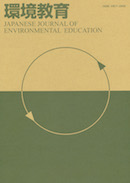Volume 27, Issue 1
Displaying 1-8 of 8 articles from this issue
- |<
- <
- 1
- >
- >|
Special Issue: The Next National Curriculum and Environmental Education
Reviews
-
2017Volume 27Issue 1 Pages 1_2-5
Published: 2017
Released on J-STAGE: June 28, 2018
Download PDF (1142K) -
2017Volume 27Issue 1 Pages 1_6-11
Published: 2017
Released on J-STAGE: June 28, 2018
Download PDF (1161K) -
2017Volume 27Issue 1 Pages 1_12-15
Published: 2017
Released on J-STAGE: June 28, 2018
Download PDF (1133K)
Articles
-
2017Volume 27Issue 1 Pages 1_16-22
Published: 2017
Released on J-STAGE: June 28, 2018
Download PDF (1268K) -
2017Volume 27Issue 1 Pages 1_23-32
Published: 2017
Released on J-STAGE: June 28, 2018
Download PDF (1332K)
Reports
-
2017Volume 27Issue 1 Pages 1_33-39
Published: 2017
Released on J-STAGE: June 28, 2018
Download PDF (1531K) -
2017Volume 27Issue 1 Pages 1_40-44
Published: 2017
Released on J-STAGE: June 28, 2018
Download PDF (1326K) -
2017Volume 27Issue 1 Pages 1_45-50
Published: 2017
Released on J-STAGE: June 28, 2018
Download PDF (1884K)
- |<
- <
- 1
- >
- >|
